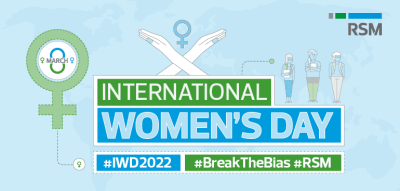IAB reporter Isabella Colletta spoke to RSM International CEO Jean Stephens about her career path, her philosophy on what it takes to become a good leader, and creating diversity in the workplace.
Isabella Colletta: Please can you outline your career and explain how you moved up the career ladder to the position of CEO at RSM International?
Jean Stephens: Continuous learning, whether formal or informal, has always been important to me. Growing up in the US, I chose to study Accounting at the University of Redlands in California, and went on to complete my master’s degree in Finance while working in the profession. With an interest in business, I entered the accountancy profession upon graduation with a focus on audit. Following a few years with a local then a regional firm, I joined RSM US, then called McGladrey.
In most people’s lives there are points of inflection, and mine proved to be an opportunity to take a secondment in the UK. It had always been a personal objective of mine to live abroad, so I leapt at the chance to immerse myself in another culture, and to gain vital experience through working internationally. While circumstance and the support of others are key to professional development, I believe it is important for an individual to drive their own career through recognising opportunities for growth and development, and taking advantage of them.
Following my relocation to London, in 1996 I began working with the global CEO at RSM International, developing and learning along the way, and was privileged to be appointed CEO in 2005.
Importantly, my progression over this period was never simply about an ambition to move up the ‘career ladder’ – it came, I believe, from finding my passion in my work with RSM leaders and dedication to building strong relationships based on trust. No doubt, my natural tenacity, drive and ambitions helped me along the way, but these qualities may have not been as forthcoming if I didn’t love what I do.
IC: How do you think being a woman has impacted your career progression? What are some of the greatest challenges that women seeking to progress to executive roles face today?
“My progression was never simply about an ambition to move up the ‘career ladder’”
JS: The issue of women in leadership has been discussed for a long time now – certainly from the time I entered the profession.
I feel someone’s gender should not bring unfair advantages to anyone’s career in the same way it shouldn’t bring disadvantages, which is why I have always found the disparity between men and women in senior leadership positions to be troubling. Consequently, as CEO of a global organisation, I have a responsibility to do all I can to support a greater number of women to reach for those senior leadership positions. However, I am equally interested in helping all those I work with to achieve their potential. As leaders, we have a duty of care to provide an inclusive environment that allows all people to flourish. I believe having a diverse team is key to continuous learning and development, both personally and organisationally.
In terms of the wider challenges women face when seeking to progress to executive roles, support that allows women to balance work and home life has not progressed as fast as it needs to in order to negate the impact of the extra responsibilities a woman often has. All research suggests that businesses function better with a diverse leadership team, yet over the last 40 years, there has only been slow improvement in terms of the number of women in the boardroom. I see this limited and gradual pace of change continuing unless there are significant interventions that seek to accelerate it, such as through the use of quotas and other tools to help drive change.
I understand that the concept of quotas may be uncomfortable for some people; indeed, many women disagree with quotas because they want to know that they have achieved something in their own right. However, quotas are not about promoting people beyond their ability – they are about providing opportunities to talented people who may otherwise have been overlooked. If used correctly, quotas might be the catalyst for short-term change that the world of business needs, and if successful, may not be required soon thereafter. This is an issue for all leaders to discuss, debate and apply to proactively contribute to the needed changes.
IC: What policies is RSM International heading to ensure gender parity in the workplace? What can the audit profession more generally do to ensure greater gender equality and inclusion in recruitment?
JS: At the global executive office, we currently have 58% of our team as female. I would add that, first and foremost, all our staff were chosen because they had the right mindset, skills, and experience to create value for our members and to our business – regardless of gender. We are flexible with regard to working days and schedules, and do all we can to take a people-first approach to our work.
As a global organisation, the diversity across our firms is our strength, and our belief in collaborating to bring together varied opinions and insight is fundamental to being able to provide our middle-market clients with innovative solutions.
Diversity and inclusion are key topics that are prioritised in both our planning and actions, and we have many cross-regional initiatives in motion that seek to build on our already-strong culture in this regard.
While each firm is legally independent, with their own HR and recruitment policies, the role of the RSM network, and my role as global CEO, is to put diversity and inclusion on the agenda, and endeavour to make collective progress across our markets in this important area, while also considering and remaining sympathetic to local cultures and working environments.
IC: As the move to home working becomes part of our new normal, what impact will this have on women seeking executive positions? And what can firms do to assist female executives with care responsibilities?
JS: As the global pandemic unfolded, the world responded at speed to a new world of remote working. Prior to Covid-19, while some organisations had dipped their toes in the water, many were reluctant to consider, let alone embrace, the concept of agile working.
It was not simply a question of having the technology in place overnight. It was, in fact, a pivotal moment at which time many employers were also confronted by the human consideration of keeping people safe. This moved quickly to considering the mental health and well-being of our teams. To do this and manage a remote workforce, there needed to be a better understanding of individuals’ personal circumstances. Almost overnight, it was suddenly very clear to leaders and management to consider whether people had young children at home, or were vulnerable themselves, or were caring for vulnerable people. This was gender-neutral.
Without question, if leaders and organisations can take what they’ve learned about their people, and are open to agile or smart working, it will remove some of the barriers – such as creating an environment that supports taking or picking up children to and from school. There are other barriers though, that are either innate or historically systemic – such as unconscious bias or structures and metrics that favour seniority or traditional male attributes.
“assuming that a diversity of identities automatically produces diversity of thought is an easy trap to fall into”
We have developed and implemented a number of programmes designed to provide inclusivity and opportunity for up-and-coming leaders at various stages of their careers, such as the RSM Academy for International and Cultural Development, NextGen Leaders and the Forward Sprint, in particular which is aimed at the youngest members in our RSM family.
We are implementing the five characteristics with which we are promoting the very behaviours that support diversity and inclusivity to enhance an exceptional culture for our people, and ultimately for our clients. There will always be more to do, and I know RSM will always rise to any challenge.
IC: Do you think diversifying the C-Suite is a priority for firms hoping to provide greater opportunities for women?
JS: Using identity alone as a metric to create diversity and encourage innovation often is not enough. It is quite possible to have a senior leadership team that includes different genders, ages, ethnicity, religious beliefs, sexual orientations and so on, yet many may think in the same way. Making the assumption that a diversity of identities automatically produces diversity of thought is an easy trap to fall into.
Diversifying the C-Suite so people with different experiences and professional attributes are listened to and indeed promoted to these senior positions is potentially another channel to build diversity into our processes and planning. Ultimately, this comes from understanding and appreciating the different perspectives that people can bring from all functions. Where there are more opportunities to add value, and where there is more understanding and respect for the different types of work that people do, there will be more opportunity for women to have a voice and progress. If you employ or appoint in your own image, the consequence is that you may risk ‘group think’, fostering institutional bias, or even a bias for short-term results as opposed to pursuing ground-breaking initiatives that are more revolutionary. Instead of seeing the differences between men and women or young and old, we should view them as corporate assets, utilising them to provide different perspectives. Lasting progress is rarely achieved by everyone simply agreeing with each other.
This content was written for and first published by The International Accounting Bulletin








